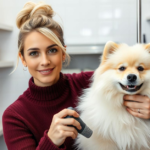India customers to view on amazon.in
How Often Should You Really Bathe Your Dog?
Determining the best dog bath routine can be challenging, as it varies based on several factors, including breed, lifestyle, and health conditions.
- Understanding Your Dog’s Bathing Needs
- Factors That Determine Bathing Frequency
- How Often Should You Really Bathe Your Dog? A Breed-By-Breed Guide
- Signs Your Dog Needs a Bath
- The Proper Dog Bathing Technique
- Choosing the Right Bathing Products
- Dog-Specific Shampoos and Conditioners
- Natural vs. Medicated Products
- Products for Specific Coat Types
- Products to Avoid
- Special Bathing Considerations
- Puppies: How Often Should You Bathe a Puppy?
- Senior Dogs
- Dogs with Sensitive Skin
- Seasonal Bathing Adjustments
- The Risks of Improper Bathing Practices
- Between-Bath Cleaning Solutions
- Conclusion: Creating the Ideal Bathing Schedule for Your Dog
- FAQ
- How often should I bathe my dog?
- What are the risks of overbathing my dog?
- How often should I bathe a puppy?
- What type of shampoo is best for my dog?
- Can I use human shampoo on my dog?
- How can I keep my dog clean between baths?
- Are there any specific bathing considerations for dogs with sensitive skin?
- How often should I bathe my indoor dog?
- Can bathing help alleviate skin problems in dogs?
- What are the benefits of regular brushing for my dog?
Understanding your dog’s specific needs is crucial in establishing a suitable dog bathing schedule. Factors such as activity level, coat type, and environmental conditions play a significant role in deciding how often to wash a dog.
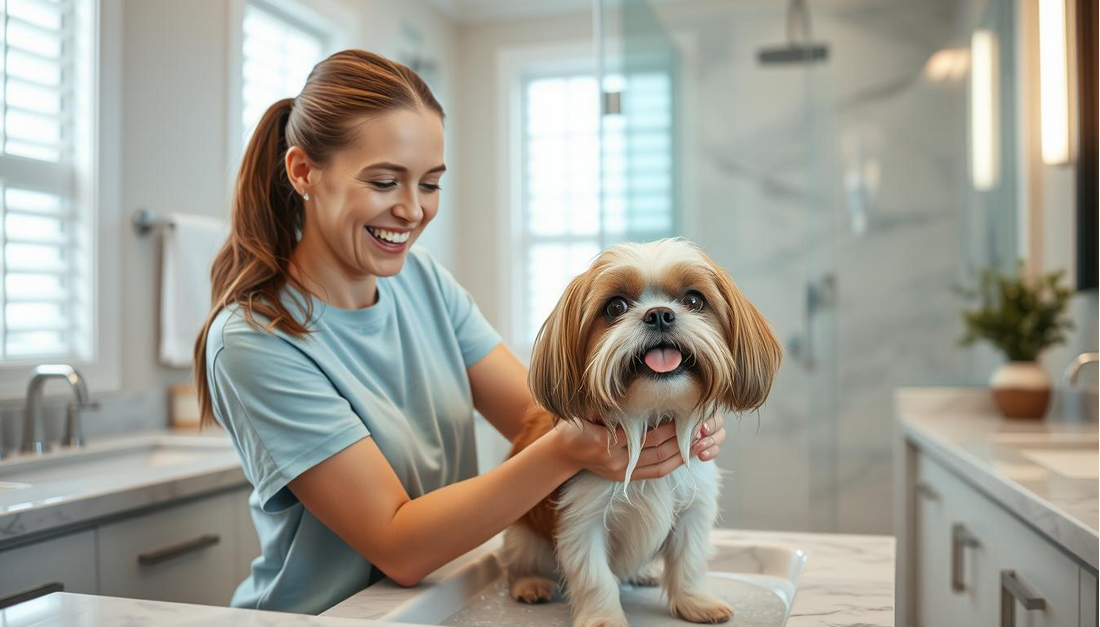
A well-planned bathing routine not only maintains your dog’s hygiene but also contributes to their overall health and well-being.
Key Takeaways
- Consider your dog’s breed and lifestyle when determining their bathing needs.
- A dog’s activity level and coat type influence their bathing frequency.
- Establishing a regular bathing routine is essential for maintaining hygiene and overall health.
- Environmental conditions, such as exposure to dirt or allergens, can impact bathing frequency.
- Consult with a veterinarian to determine the best bathing schedule for your dog.
Understanding Your Dog’s Bathing Needs
Understanding your dog’s bathing needs is crucial for maintaining their overall health and hygiene. Dogs have unique skin and coat requirements that need to be considered when determining their bathing frequency.
Natural Oils and Skin Health
Dogs have a natural coat that is protected by oils, which help to keep their skin healthy and their coat shiny. Over-bathing can strip these natural oils, leading to dry, irritated skin. Maintaining the right balance is key to preserving the health of your dog’s skin and coat.
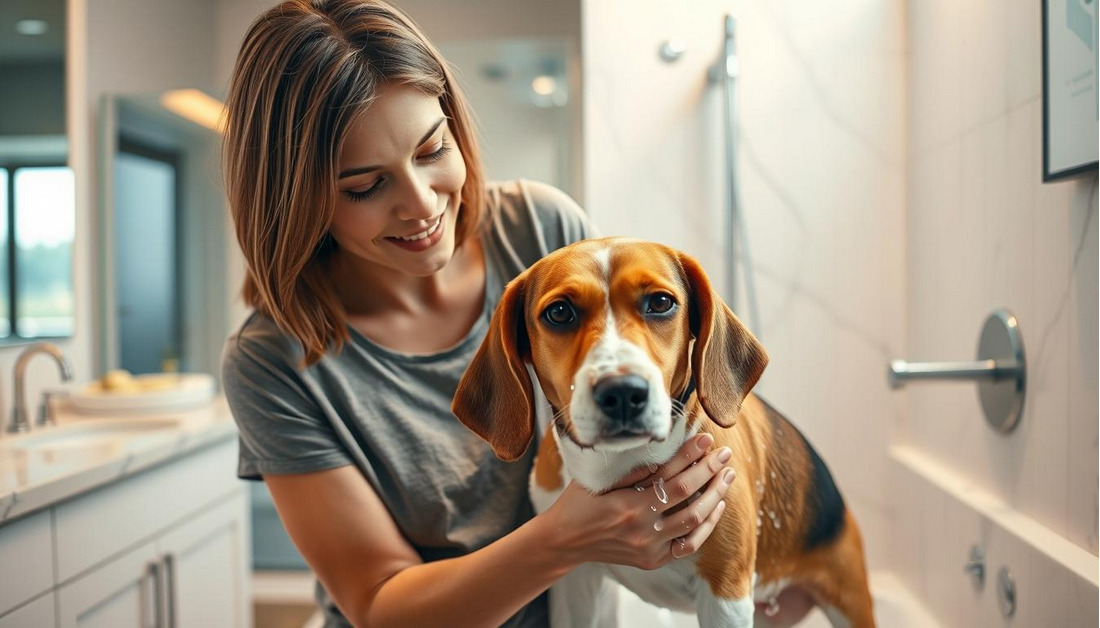
The Purpose of Dog Bathing
Bathing your dog serves several purposes: it removes dirt and debris, reduces body odor, and helps to distribute skin oils. However, bathing too frequently can be detrimental, causing more harm than good by stripping the coat of its natural protective layers.
Balancing Cleanliness and Skin Protection
To strike the right balance, consider your dog’s lifestyle, coat type, and health conditions. For instance, dogs that spend a lot of time outdoors may require more frequent bathing than those that stay indoors. A regular grooming routine can also help maintain cleanliness between baths.
| Coat Type | Bathing Frequency | Special Considerations |
|---|---|---|
| Short-Haired | Every 4-6 weeks | May require less frequent bathing |
| Long-Haired | Every 2-6 weeks | May require more frequent grooming |
By understanding these factors and adjusting your dog’s bathing schedule accordingly, you can help maintain their skin health and overall hygiene.
Factors That Determine Bathing Frequency
Understanding the factors that determine your dog’s bathing frequency is essential for their grooming and overall well-being. Several elements come into play when deciding how often to bathe your dog, including their breed, coat type, activity level, environment, and health conditions.
Breed and Coat Type
Different breeds have unique coat characteristics that influence their bathing needs. For instance:
- Short-haired breeds like Boxers and Beagles require less frequent bathing compared to long-haired breeds like Afghan Hounds and Old English Sheepdogs.
- Double-coated breeds, such as Siberian Huskis and Golden Retrievers, need special care to maintain their coat’s health.
The coat type plays a significant role in determining the bathing frequency. Dogs with oily coats, like Basset Hounds, may require more frequent bathing than those with dry coats.
Activity Level and Environment
A dog’s lifestyle significantly impacts their bathing needs. Consider the following factors:
Indoor vs. Outdoor Dogs
Dogs that spend more time outdoors, especially in dirty or muddy areas, will need more frequent bathing than those that stay indoors. Indoor dogs may require less frequent bathing, but their coats still need regular maintenance.
Swimming and Outdoor Activities
Dogs that engage in swimming, hiking, or other outdoor activities may need more frequent bathing to remove dirt, debris, and potential allergens or irritants.
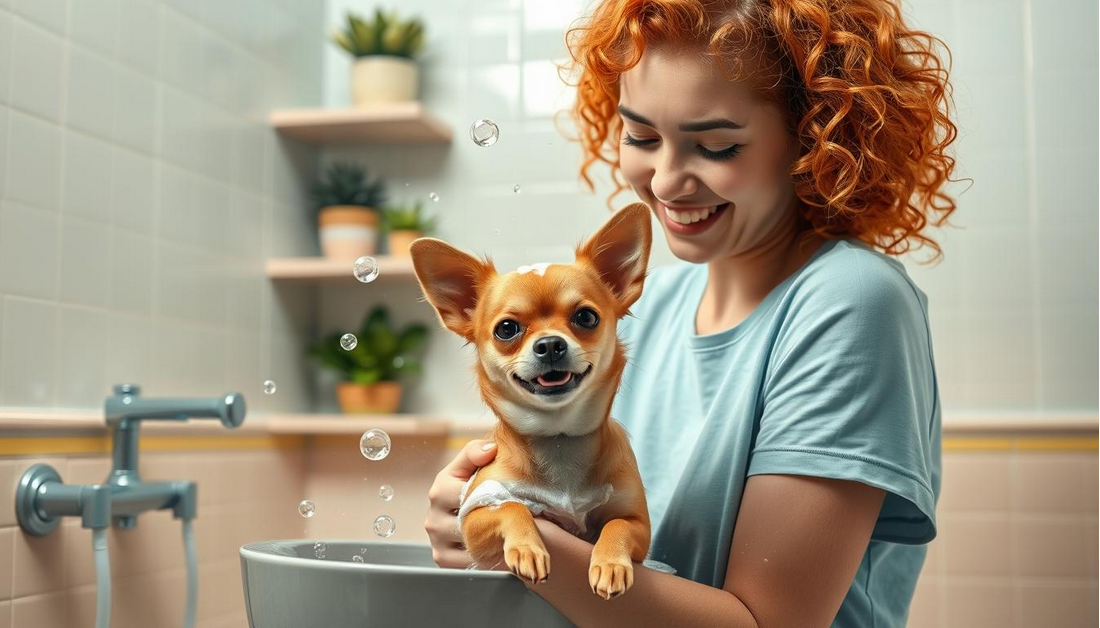
For example, dogs that swim regularly may need bathing after each swim to prevent skin irritation and infections.
Health Conditions
Dogs with certain health conditions, such as skin allergies or flea infestations, may require more frequent bathing with medicated shampoos. Consult with your veterinarian to determine the best bathing schedule for your dog’s specific health needs.
How Often Should You Really Bathe Your Dog? A Breed-By-Breed Guide
The ideal bathing schedule for your dog is influenced by their breed, coat type, and lifestyle. Understanding these factors is crucial in determining the best dog bath routine for your pet.
Short-Haired Breeds
Short-haired breeds, such as Beagles and Boxers, typically require bathing every 4-6 weeks. Their coats are relatively easy to maintain, but they still need regular cleaning to remove dirt and debris. Overbathing can strip their coat of natural oils, leading to dry skin.
Medium-Haired Breeds
Medium-haired breeds, like Cocker Spaniels and Australian Shepherds, need bathing every 4-8 weeks. Their coats require more attention than short-haired breeds, as they can mat and tangle. Regular brushing is essential to prevent these issues.

Long-Haired Breeds
Long-haired breeds, such as Shih Tzus and Afghan Hounds, require more frequent bathing, typically every 2-6 weeks. Their long coats can mat and tangle easily, so regular grooming is crucial. Daily brushing is recommended to prevent these issues.
Double-Coated Breeds
Double-coated breeds, like Siberian Huskies and Golden Retrievers, need bathing every 8-12 weeks. Their coats have a soft undercoat and a coarser outer coat, which can shed heavily. Overbathing can damage their coat, so it’s essential to bathe them only when necessary.
Hairless Breeds
Hairless breeds, such as the Chinese Crested, require weekly bathing to remove oils and dirt from their skin. Their skin can become oily and dirty quickly, so regular cleaning is essential to prevent skin problems.
By understanding your dog’s breed and coat type, you can determine the best bathing guidelines for dogs and maintain their overall health and hygiene. Regular grooming and bathing can help prevent skin problems and keep your dog’s coat clean and healthy.
Signs Your Dog Needs a Bath
Recognizing the signs that indicate your dog is due for a bath is crucial for their hygiene and health. Keeping your dog clean is an essential part of their care routine, and understanding when to bathe them can make all the difference in their overall well-being.
Visible Dirt and Debris
If your dog has visible dirt, debris, or dirt matting in their coat, it’s a clear sign that they need a bath. Regular inspections can help you catch these issues early, making the bathing process easier and less stressful for your dog.
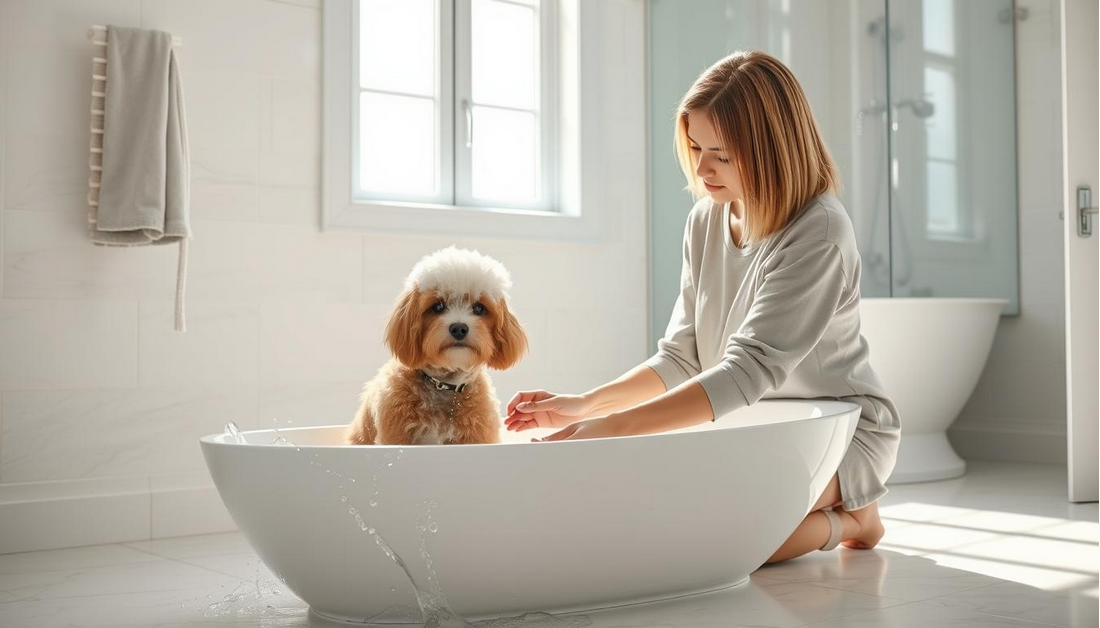
Odor Issues
A strong, unpleasant odor from your dog’s coat or skin is a strong indicator that it’s time for a bath. Regular bathing can help minimize odor issues, keeping your dog smelling fresh and clean.
Skin Problems
If your dog is experiencing skin irritations, redness, or infections, a bath with the right shampoo can be a crucial step in their treatment. Always consult with your veterinarian to determine the best course of action for skin issues.
Seasonal Allergies
Dogs with seasonal allergies may benefit from more frequent bathing during peak allergy seasons to remove allergens from their coat. This can help alleviate some of the discomfort associated with allergies.
| Signs | Bathing Frequency | Additional Care |
|---|---|---|
| Visible Dirt/Debris | As needed | Regular brushing |
| Odor Issues | Every 1-2 weeks | Deodorizing sprays |
| Skin Problems | As advised by vet | Medicated shampoos |
| Seasonal Allergies | More frequently during allergy season | Anti-allergen measures |
The Proper Dog Bathing Technique
A proper dog bathing technique is crucial for maintaining your dog’s overall health and cleanliness. Bathing your dog at home can be a straightforward process if you follow the right steps, ensuring your dog’s hygiene and grooming needs are met.
Pre-Bath Preparation
Before you start bathing your dog, it’s essential to prepare them properly. This involves two critical steps: brushing and detangling, and gathering supplies.
Brushing and Detangling
Brushing your dog’s coat before a bath helps remove tangles and mats, making the bathing process smoother. It also helps distribute natural oils throughout their coat, promoting healthy skin and a shiny coat. Use a brush suitable for your dog’s coat type to gently work out any knots.
Gathering Supplies
Gather all necessary supplies before starting the bath to ensure a smooth process. You’ll need a dog-specific shampoo and conditioner, towels, a washcloth, and a non-slip mat for the bathtub. Having everything within reach will make the experience less stressful for both you and your dog.
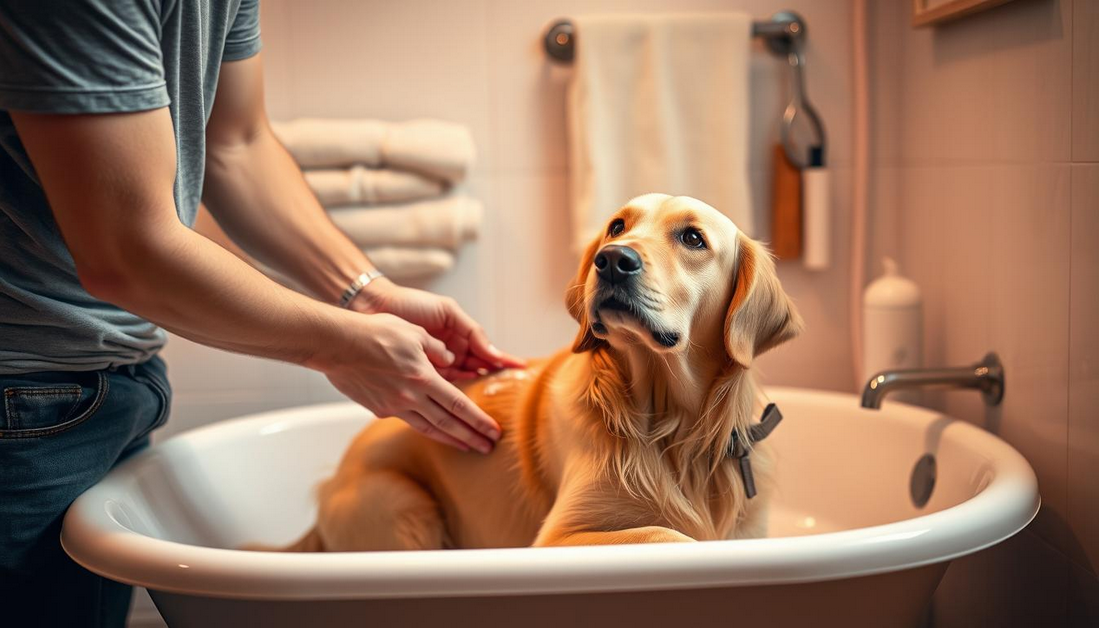
Step-by-Step Bathing Process
The bathing process should be done carefully to avoid irritating your dog’s skin. Start by wetting your dog’s coat thoroughly with warm water, then apply a dog-specific shampoo, working it into a lather. Be sure to avoid sensitive areas such as the eyes, ears, and nose. Rinse your dog thoroughly to remove all soap residue.
Drying Methods
After the bath, gently pat your dog dry with a towel to remove excess water. You can also use a blow dryer on a low setting to dry your dog’s coat, especially if they have a thick or long coat. Be cautious not to scare your dog with the noise or burn their skin with excessive heat.
Post-Bath Care
Post-bath care is just as important as the bath itself. Apply a dog-specific conditioner or a leave-in product to help detangle and moisturize your dog’s coat. Regular grooming after the bath will keep your dog’s coat healthy and shiny, and it’s also a great opportunity to check for any skin issues or irritations.
Choosing the Right Bathing Products
The key to a successful bathing routine lies in selecting the correct dog bathing products. With so many options available, it can be overwhelming to decide what is best for your dog.
When it comes to bathing your dog, the products you use can significantly impact their coat health and overall well-being. Using the right products can help maintain the natural oils in your dog’s coat, prevent skin irritation, and keep them clean and fresh.
Dog-Specific Shampoos and Conditioners
It’s essential to use dog-specific shampoos and conditioners that are formulated for your dog’s specific needs. Human shampoos are not suitable for dogs as they can strip their coat of natural oils, leading to dryness and irritation.
Dog shampoos come in various types, including moisturizing, medicated, and hypoallergenic. Choose a shampoo that addresses your dog’s specific skin or coat concerns.
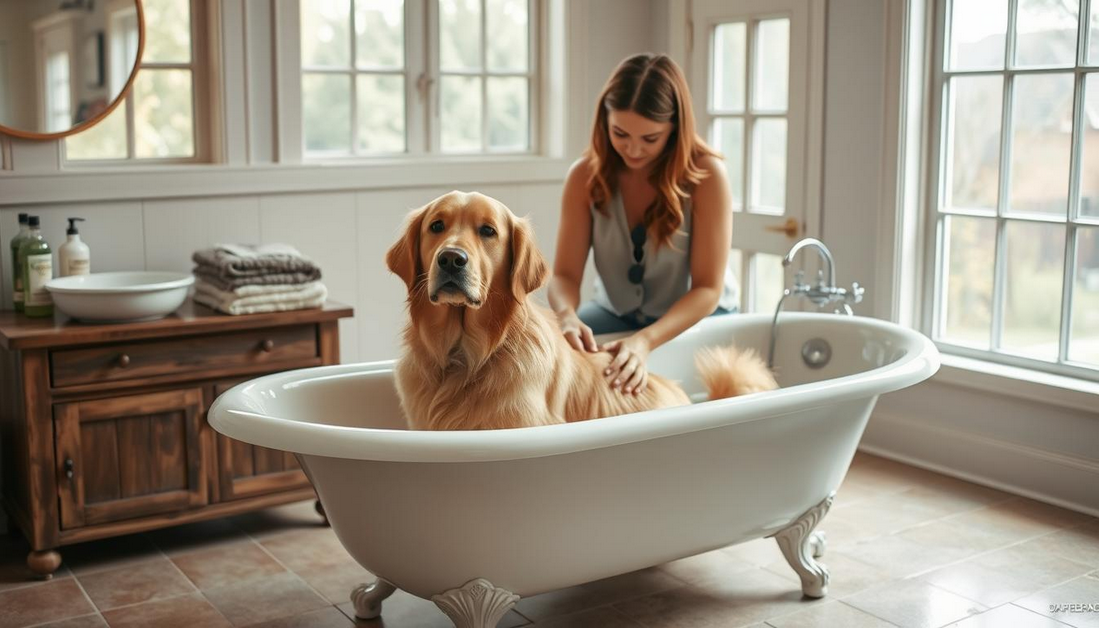
Natural vs. Medicated Products
Natural dog bathing products are ideal for dogs with sensitive skin or allergies. They are typically free from harsh chemicals and artificial fragrances. Medicated products, on the other hand, are designed to address specific skin issues such as fungal or bacterial infections.
When deciding between natural and medicated products, consider your dog’s health needs. If your dog has a skin condition, consult with your veterinarian to determine the best product.
Products for Specific Coat Types
Different coat types require specific care. For example, dogs with long hair may benefit from a conditioning shampoo to prevent matting, while short-haired dogs may require a gentle, non-stripping shampoo.
| Coat Type | Recommended Product |
|---|---|
| Long Hair | Conditioning Shampoo |
| Short Hair | Gentle, Non-Stripping Shampoo |
| Sensitive Skin | Hypoallergenic Shampoo |
Products to Avoid
Some dog bathing products contain harsh chemicals that can irritate your dog’s skin or strip their coat of natural oils. Avoid products with artificial fragrances, dyes, or sulfates.
Always read the ingredient label and look for products that are labeled as gentle and non-toxic.
Special Bathing Considerations
Bathing your dog is not a one-size-fits-all task, as different life stages and conditions require special considerations. Factors such as age, health, and lifestyle play a significant role in determining the best bathing schedule for your dog.
Puppies: How Often Should You Bathe a Puppy?
Puppies require gentle care, especially when it comes to bathing. It’s generally recommended to bathe puppies once every few weeks, depending on their activity level and environment. Overbathing can strip their coat of natural oils, leading to dry skin. Use a mild, puppy-specific shampoo to avoid irritating their sensitive skin.
Senior Dogs
Senior dogs may require more frequent bathing due to decreased mobility, which can lead to dirt accumulation on their coat. However, their skin can be more sensitive, so it’s essential to use gentle, age-appropriate shampoos. Consult with your veterinarian to determine the best bathing schedule for your senior dog.
Dogs with Sensitive Skin
Dogs with sensitive skin need extra care when bathing. It’s crucial to identify and avoid products that cause irritation.
Allergies and Irritations
If your dog has allergies or skin irritations, look for shampoos that are hypoallergenic and fragrance-free. Oatmeal-based shampoos are often recommended for their soothing properties.
Recommended Products
Some recommended products for dogs with sensitive skin include:
| Product | Key Ingredients | Benefits |
|---|---|---|
| Oatmeal Dog Shampoo | Oatmeal, Aloe Vera | Soothes irritated skin, moisturizes |
| Hypoallergenic Dog Shampoo | No fragrances, hypoallergenic formula | Reduces risk of allergic reactions |
Seasonal Bathing Adjustments
Seasonal changes can impact your dog’s bathing needs. For example, during spring and summer, dogs may need more frequent bathing due to increased outdoor activity and pollen. In contrast, during winter, less frequent bathing may be necessary to prevent dry skin.
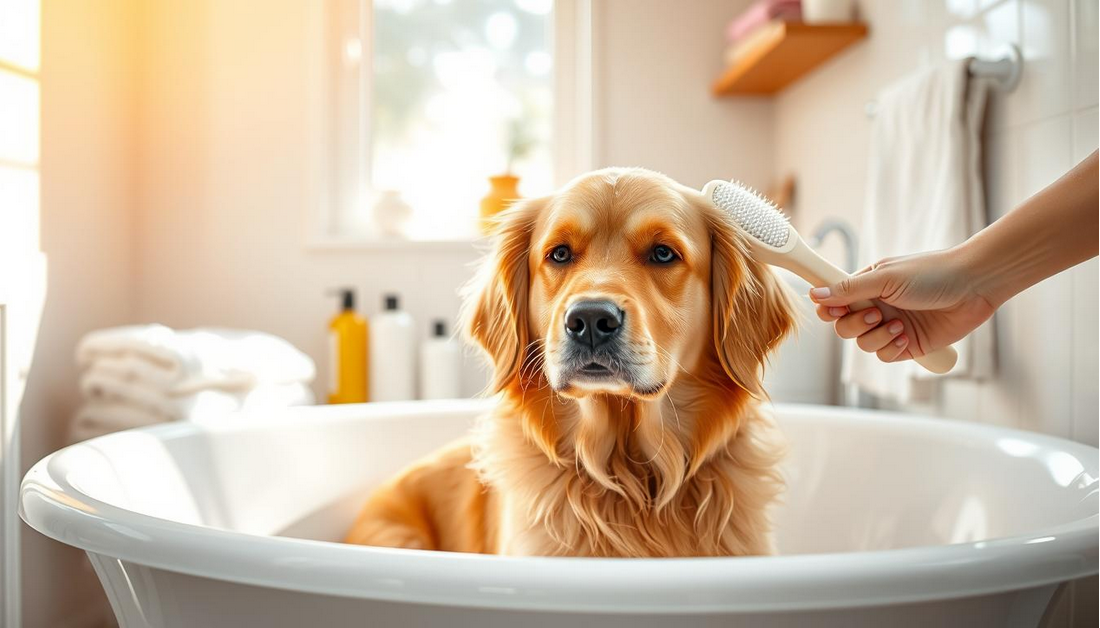
By considering these special bathing considerations, you can tailor a bathing routine that meets your dog’s unique needs, ensuring they stay clean, healthy, and comfortable throughout their life.
The Risks of Improper Bathing Practices
Improper bathing practices can lead to a myriad of issues for your dog, ranging from skin irritation to more severe health problems. Understanding these risks is crucial for maintaining your dog’s overall health and hygiene.
Overbathing Consequences
Overbathing can strip your dog’s coat of its natural oils, leading to dryness and irritation. This is particularly problematic for dogs with sensitive skin.
Dry Skin and Irritation
Dry skin can become flaky and itchy, causing discomfort for your dog. Regular moisturizing may be necessary to counteract this effect.
Disruption of Natural Oils
The natural oils in your dog’s coat play a crucial role in protecting their skin. Overbathing disrupts this balance, potentially leading to skin issues.
Underbathing Issues
On the other hand, underbathing can result in dirt and oil buildup, potentially causing skin problems and unpleasant odors.
Using Incorrect Products
Using shampoos and conditioners not formulated for dogs can cause skin irritation and other issues. Always choose dog-specific products.
Water Temperature Concerns
Water that is too hot or cold can be uncomfortable or even harmful. Lukewarm water is ideal for bathing your dog.
Between-Bath Cleaning Solutions
Maintaining your dog’s cleanliness between baths can be achieved through various methods. Regular grooming is essential for their overall health and hygiene.
Dry Shampoos and Wipes
Dry shampoos and wipes are convenient for quick cleanups. They can absorb dirt and odors, leaving your dog smelling fresh. Choose products specifically designed for dogs to avoid skin irritation.
Some popular dry shampoo brands include:
- Earthbath
- Furminator
- Pet Head
Spot Cleaning Techniques
Spot cleaning involves targeting specific dirty areas on your dog. Use a damp cloth or dog wipes to clean dirty paws or faces. For more stubborn stains, a mild dog shampoo can be applied directly to the area.
Regular Brushing Benefits
Regular brushing not only reduces shedding but also distributes natural oils, keeping your dog’s coat healthy. It’s an effective way to keep your dog clean between baths.
“Brushing your dog regularly can reduce the need for frequent bathing by distributing skin oils and preventing matting.”
Deodorizing Sprays
Deodorizing sprays can be used to eliminate odors between baths. Look for sprays made with natural ingredients to avoid irritating your dog’s skin.
| Cleaning Method | Benefits | Precautions |
|---|---|---|
| Dry Shampoos | Quick cleanup, absorbs dirt and odors | Avoid using human products |
| Spot Cleaning | Targets specific dirty areas | Be gentle to avoid irritation |
| Regular Brushing | Distributes natural oils, reduces shedding | Choose the right brush for your dog’s coat |
| Deodorizing Sprays | Eliminates odors | Opt for natural ingredients |
By incorporating these between-bath cleaning solutions into your dog grooming routine, you can keep your dog clean, healthy, and happy.
Conclusion: Creating the Ideal Bathing Schedule for Your Dog
Determining how often to bathe your dog can be a challenging task, but with the right guidance, you can create a dog care routine that meets your dog’s specific needs. By considering factors such as breed, coat type, activity level, and health conditions, you can develop a best dog bath routine that keeps your dog clean and healthy.
To establish an effective dog grooming tips routine, consider your dog’s individual requirements. For example, dogs with skin allergies may require more frequent bathing, while dogs with dry skin may need less frequent bathing. By understanding your dog’s needs, you can create a bathing schedule that promotes healthy skin and a shiny coat.
By following the guidelines outlined in this article, you can answer the question “how often should you really bathe your dog?” and develop a bathing routine that works for you and your dog. With a little practice and patience, you’ll be able to create a dog care routine that keeps your dog happy, healthy, and clean.





